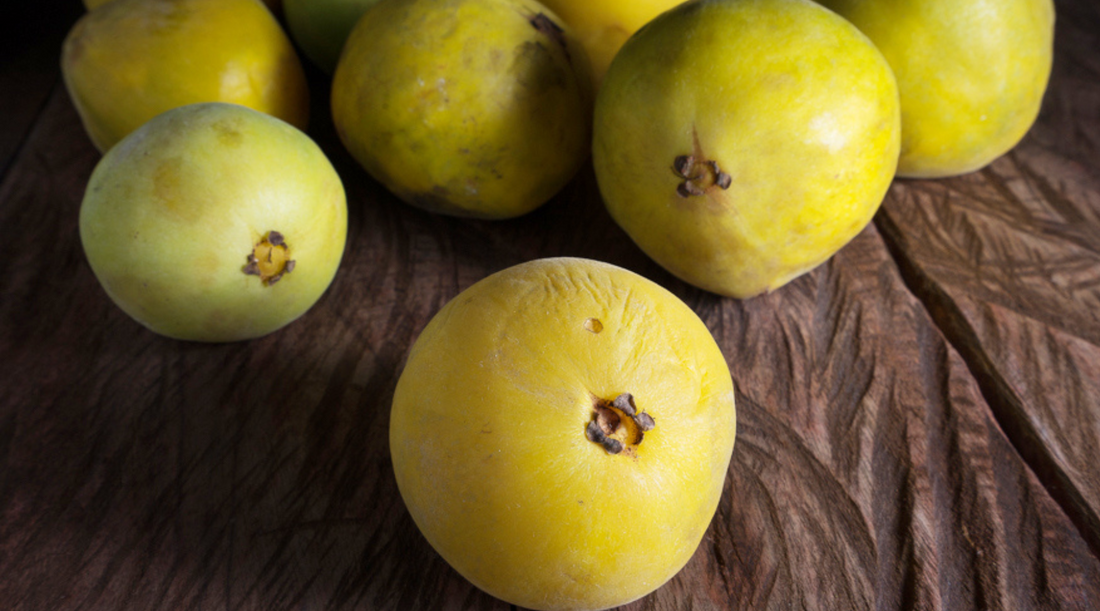Our name, Araza, comes from a rare fruit grown in the jungles of the amazon rainforest.
It’s in the same botanical family (Myrtaceae) as clove, guava, allspice, and eucalyptus. And, araza fruit has an impressive nutrient profile! It is particularly rich in potassium, calcium, magnesium, and vitamin C, but it’s the beneficial phytonutrients araza fruit contains that really set it apart, including polyphenols, carotenoids, and terpenes.
Due to it's nutraceutical like properties it has some pretty impressive skin loving benefits; We wild pick it from the jungles of the amazon (sounds so romantic I know) and it is immediately turned it into an extract so that it retains it's skin healing properties.
Araza fruit contains an array of beneficial polyphenols, especially vanillic acid, gallic acid, mallic acid, catechins, luteolin, apigenin, myricetin, quercetin, kaempferol.

WHEN APPLIED TOPICALLY
Vanillic Acid
Has antioxidant and anti-inflammatory properties, and has been shown to protect against hypopigmentation and may even be beneficial for vitiligo by improving the health of melanocytes.
Gallic Acid
Is used throughout the cosmetic industry for its skin brightening and anti-aging benefits, but it also has therapeutic uses for atopic dermatitis, hyperpigmentation, and wound healing due to its antioxidant, anti-inflammatory, antimicrobial and anti-cancer properties.
Malic Acid
Is a humectant so it can help improve skin hydration. It also acts as a gentle exfoliant while increasing skin cell turnover rate, helping to improve skin texture and the appearance of fine lines and wrinkles.
Catechins
Have been shown to protect skin from photoaging due to UV exposure thanks to their potent antioxidant effects, but perhaps even more excitingly, catechins activate collagen synthesis and inhibit matrix metalloproteinase enzyme production, increasing skin elasticity and reducing fine lines and wrinkles.
Luteolin
Is a well-known modulator of skin aging and inflammation by protecting the skin from the impacts of UV light as well as potent anti-inflammatory and antioxidant properties. In fact, Luteolin has been shown to be a promising therapeutic agent for a variety of inflammatory skin conditions.
Apigenin
Has been shown to improve the health of the skin barrier by stimulating cell turnover, lipid synthesis, and the skin’s natural production of antimicrobial peptides.
Myricetin
Has been shown to help protect skin from photoaging due to UV exposure, reduce inflammation (including from atopic dermatitis), and speed up wound healing thanks to its potent anti-inflammatory and antioxidant properties
Quercetin
Is able to reduce redness, itching, and inflammation of damaged skin (including from histamine, toxins, and UV light), and restore skin barrier function by reducing the breakdown of collagen, increasing hydration, and reducing water loss.
Kaempferol
Reduces inflammation, enhances wound healing and is an emollient, meaning it softens skin.
I mean, wow, right? And, if that wasn’t enough, araza fruit is also packed with carotenoids, including α-carotene, β-carotene, lutein, zeaxanthin, β-cryptoxanthin, and zeinoxanthin.
A-carotene and β-carotene
Are carotene carotenoids and are converted into retinoids by enzymes in the skin, which increases skin cell turnover rate and collagen synthesis to reduce hyperpigmentation, acne and wrinkles. Bonus: these vitamin A precursors are better absorbed into the skin than retinoids, with one study showing that topically applying β-carotene led to a 10X increase in retinoids in human skin.
Lutein and Zeaxanthin
Are xanthophyll carotenoids and filter high-energy wavelengths of visible light (blue and UV) and act as antioxidants, in addition to increasing lipid synthesis and reducing lipid oxidation, which improves skin hydration, elasticity and tone.
β-cryptoxanthin and zeinoxanthin are also xanthophyll carotenoids similar to lutein and zeaxanthin with potent antioxidant activity. They have been shown to improve skin health when consumed in the diet, but have not yet been extensively studied for topical applications.
Finally, araza fruit also contains some awesome monoterpenes, including α-pinene, β-pinene, and d-limonene. Limonene is a potent antioxidant with anti-inflammatory and anticancer properties. Pinene is also a potent anti-inflammatory agent. And, both limonene and pinene have strong antimicrobial properties.
You can find Araza Fruit Extract in all of our products at arazabeauty.com
Research credit to Dr. Sarah Ballantyne
